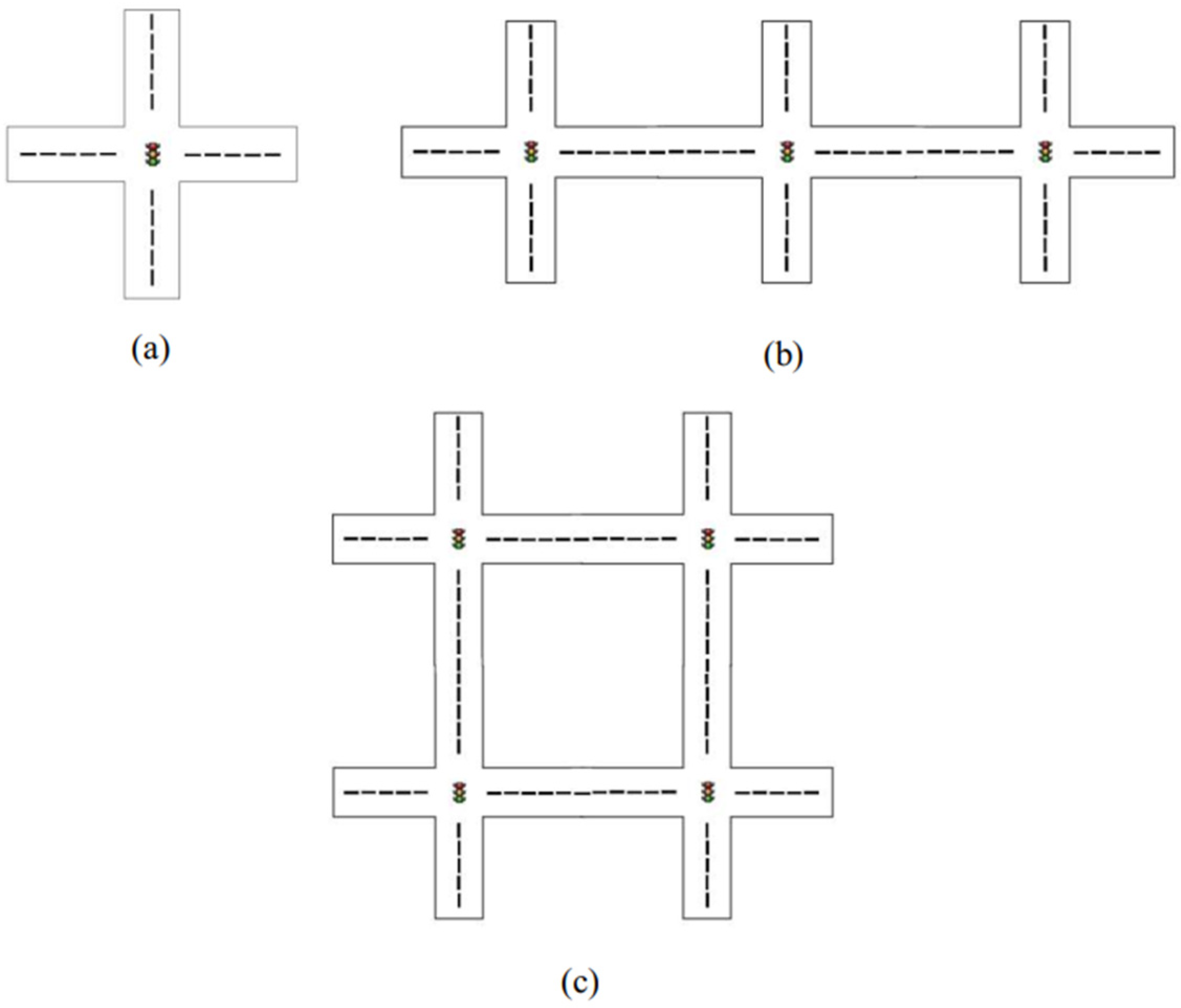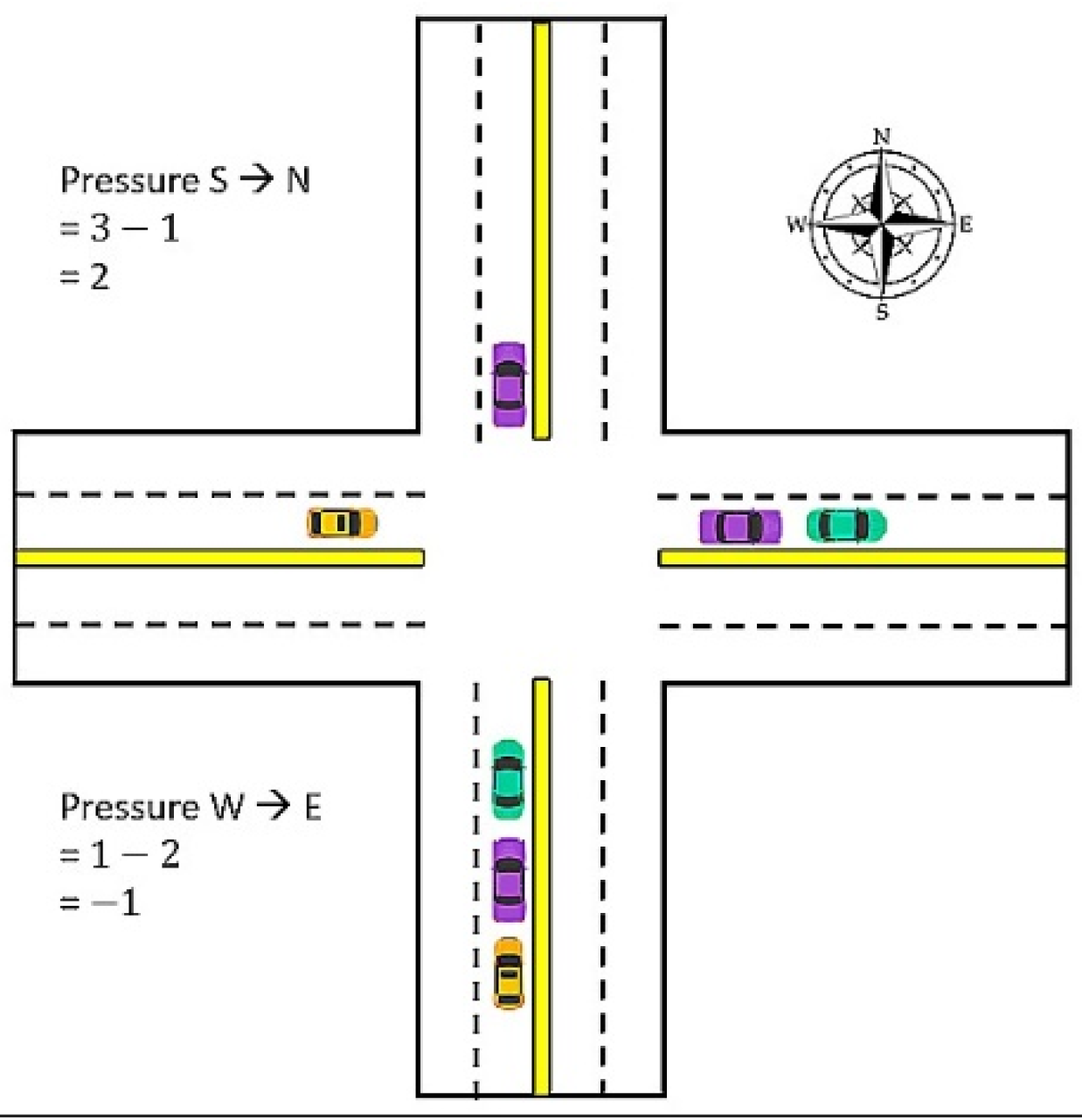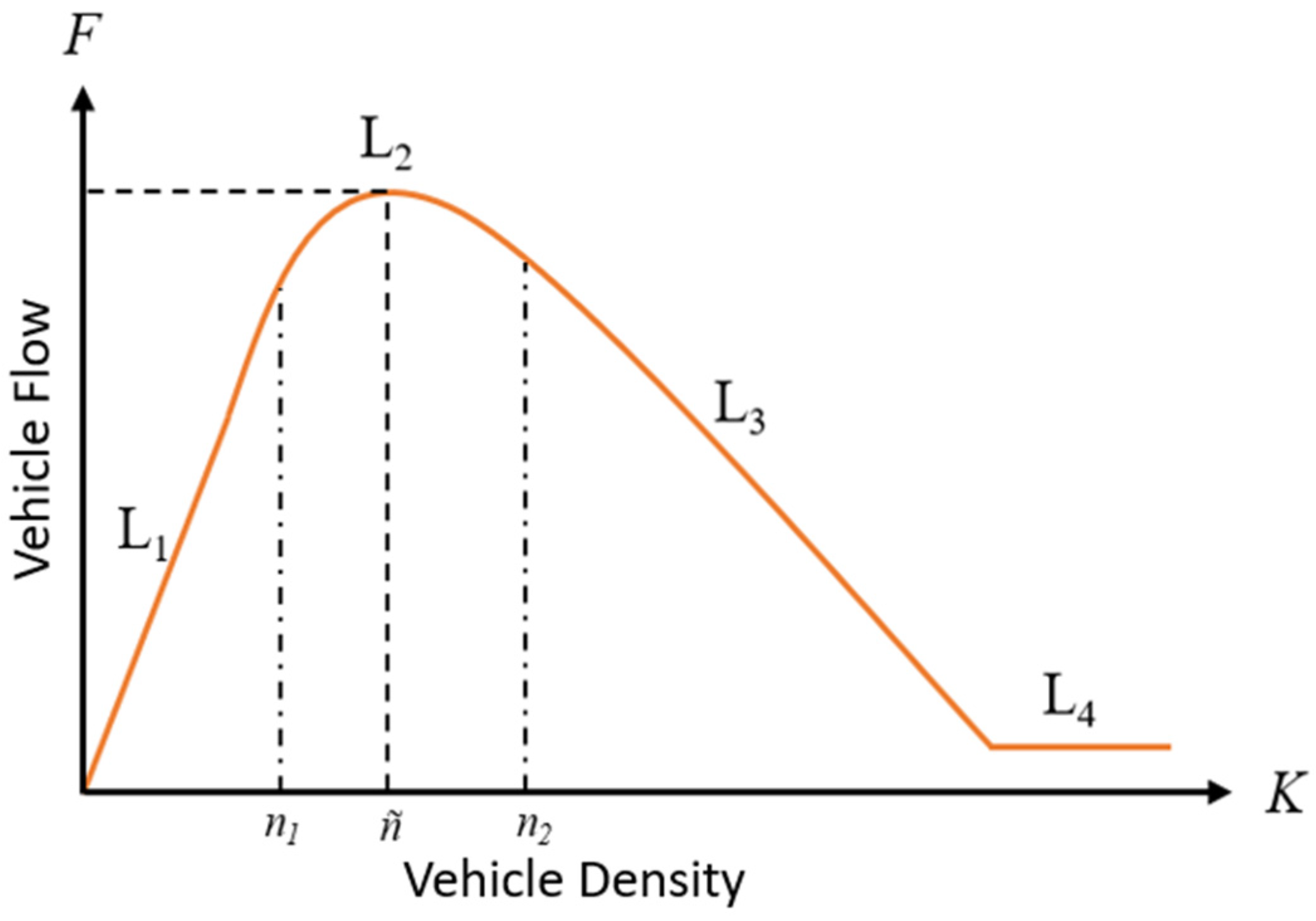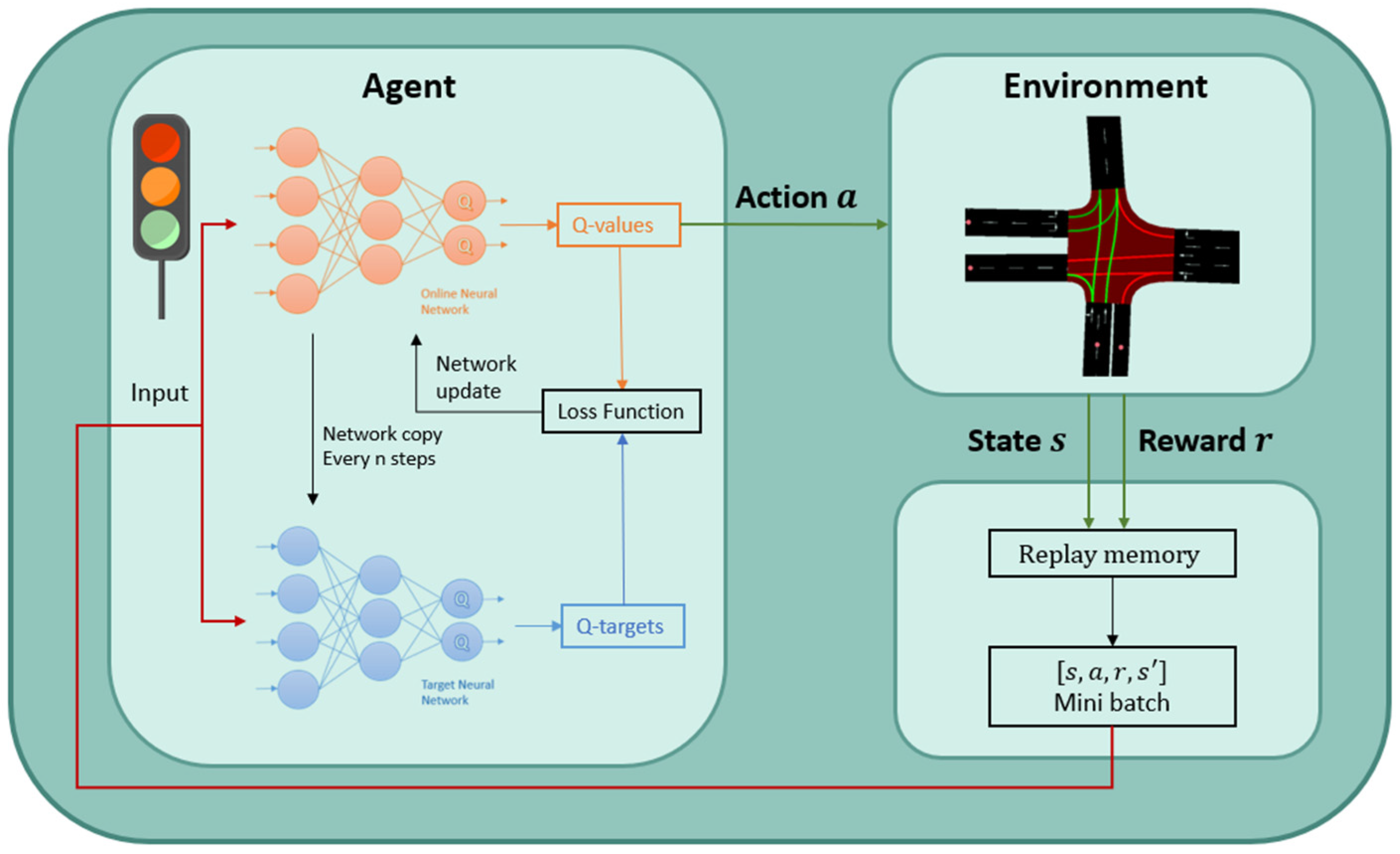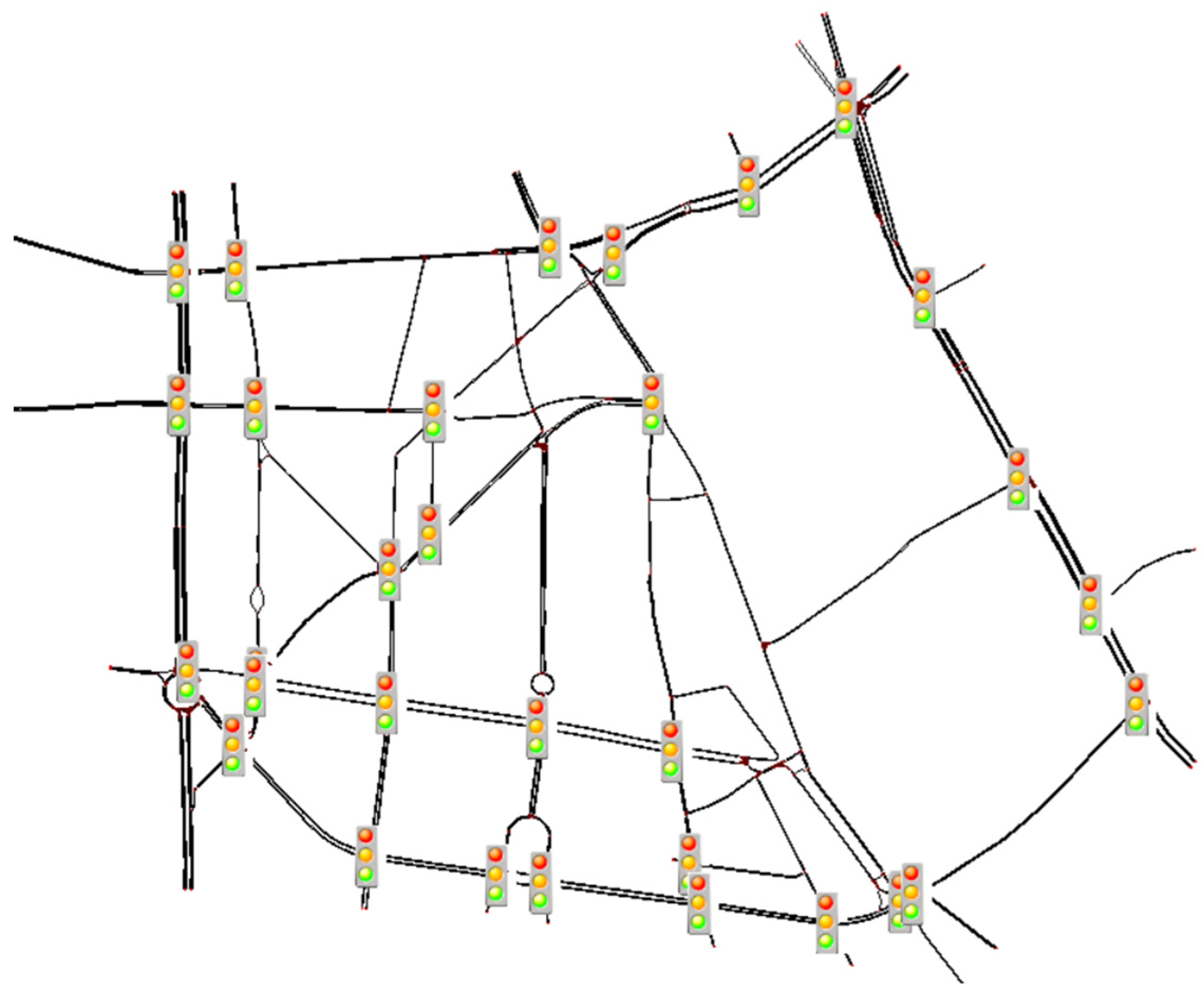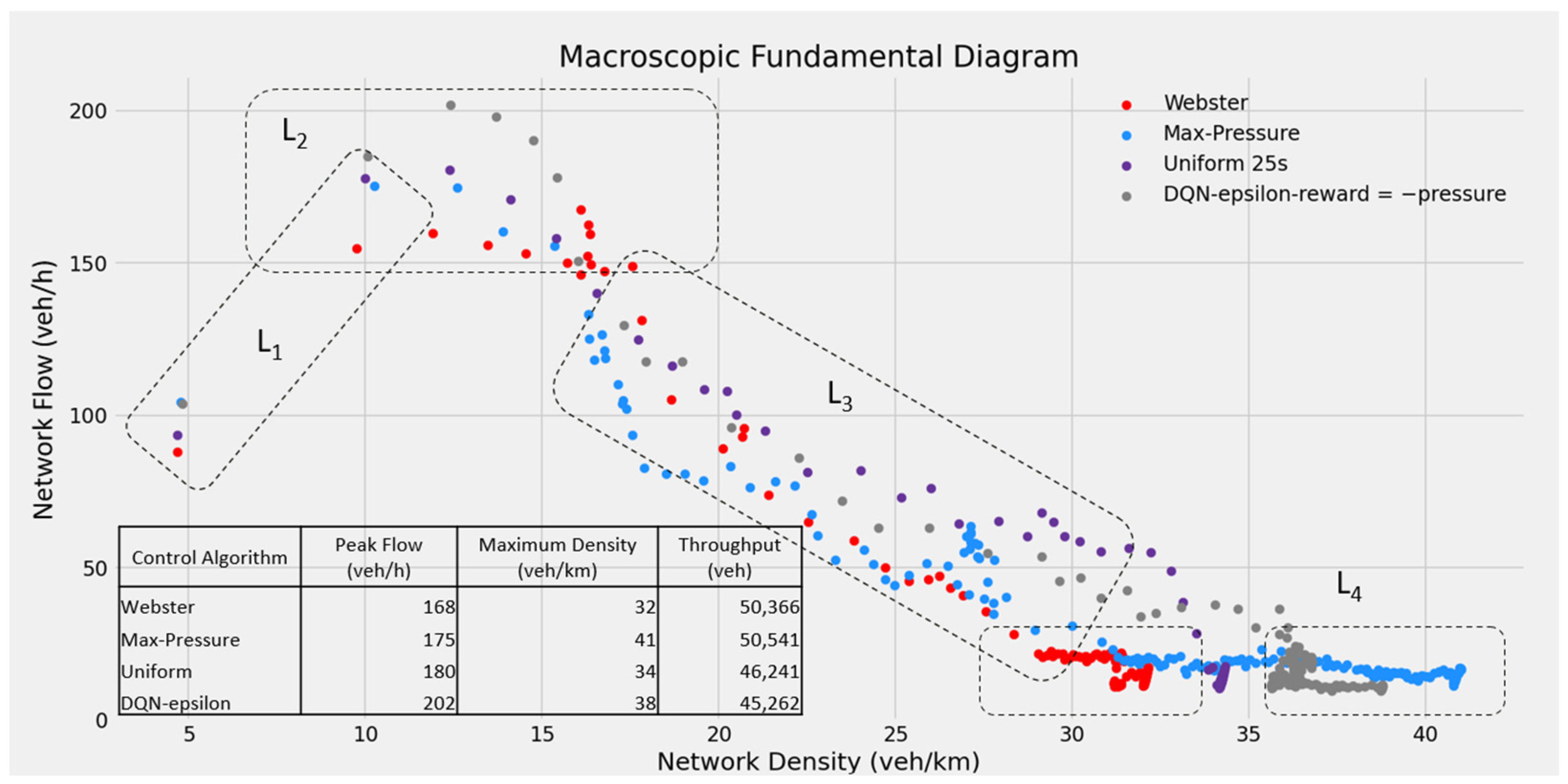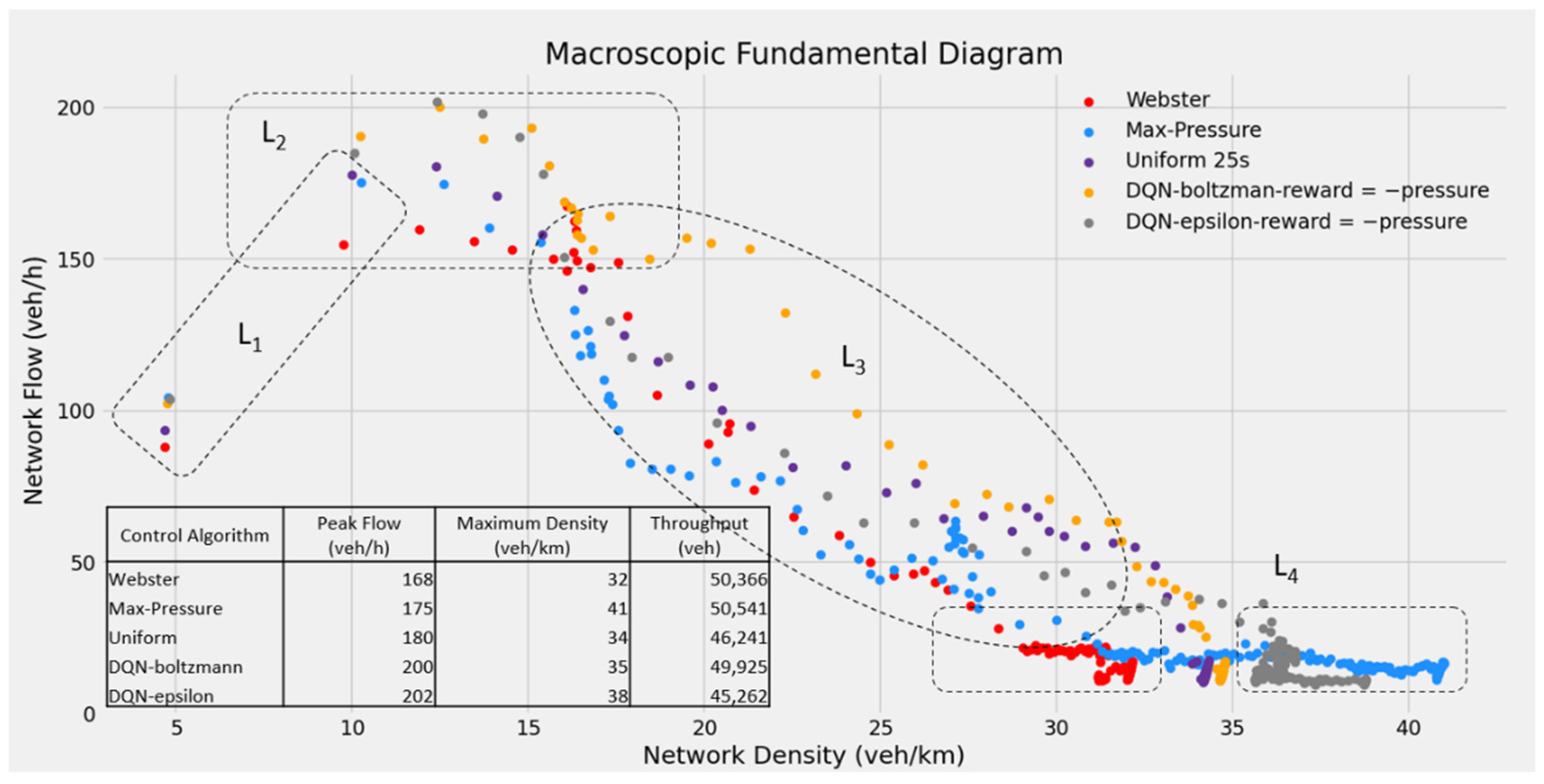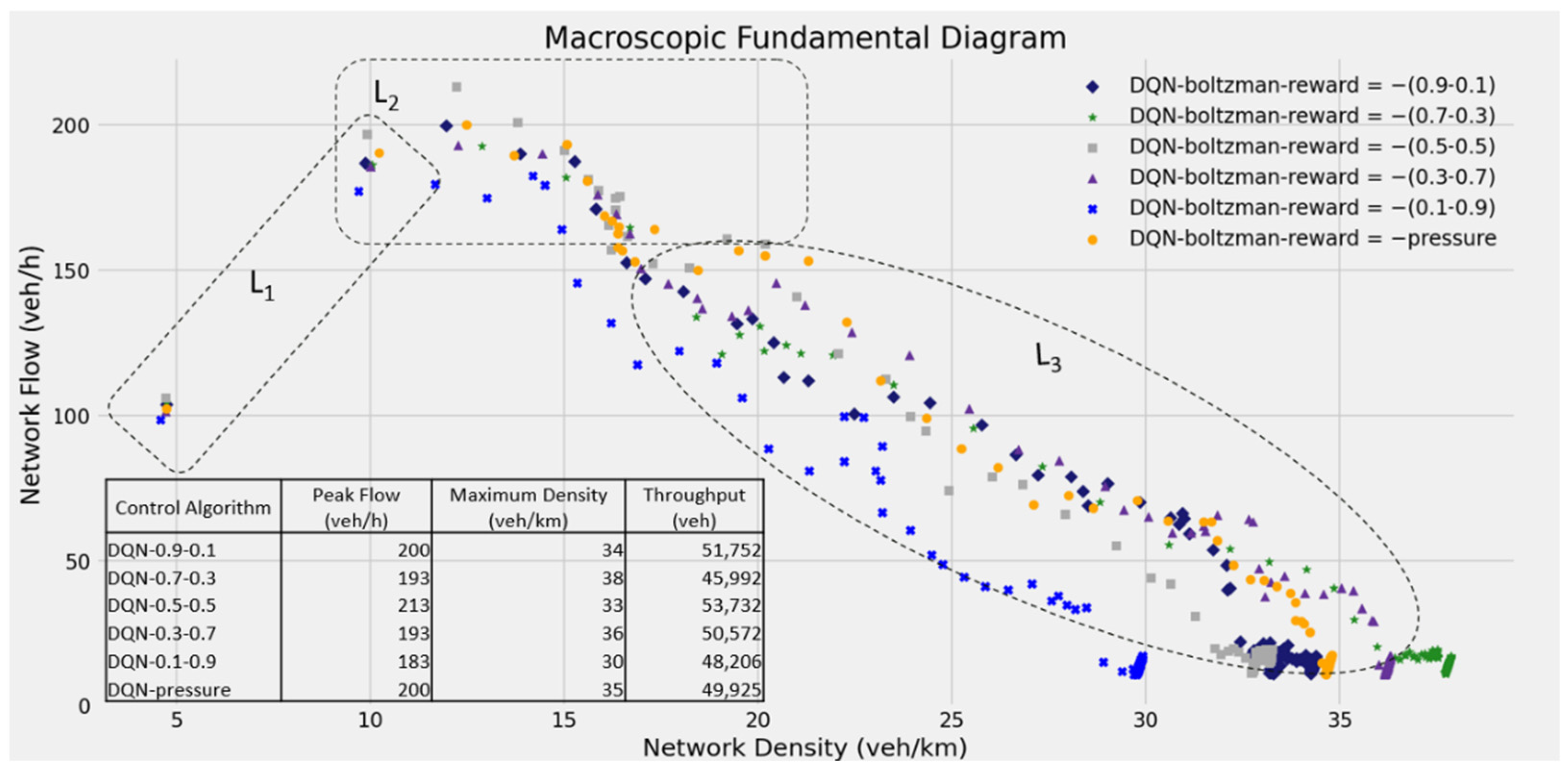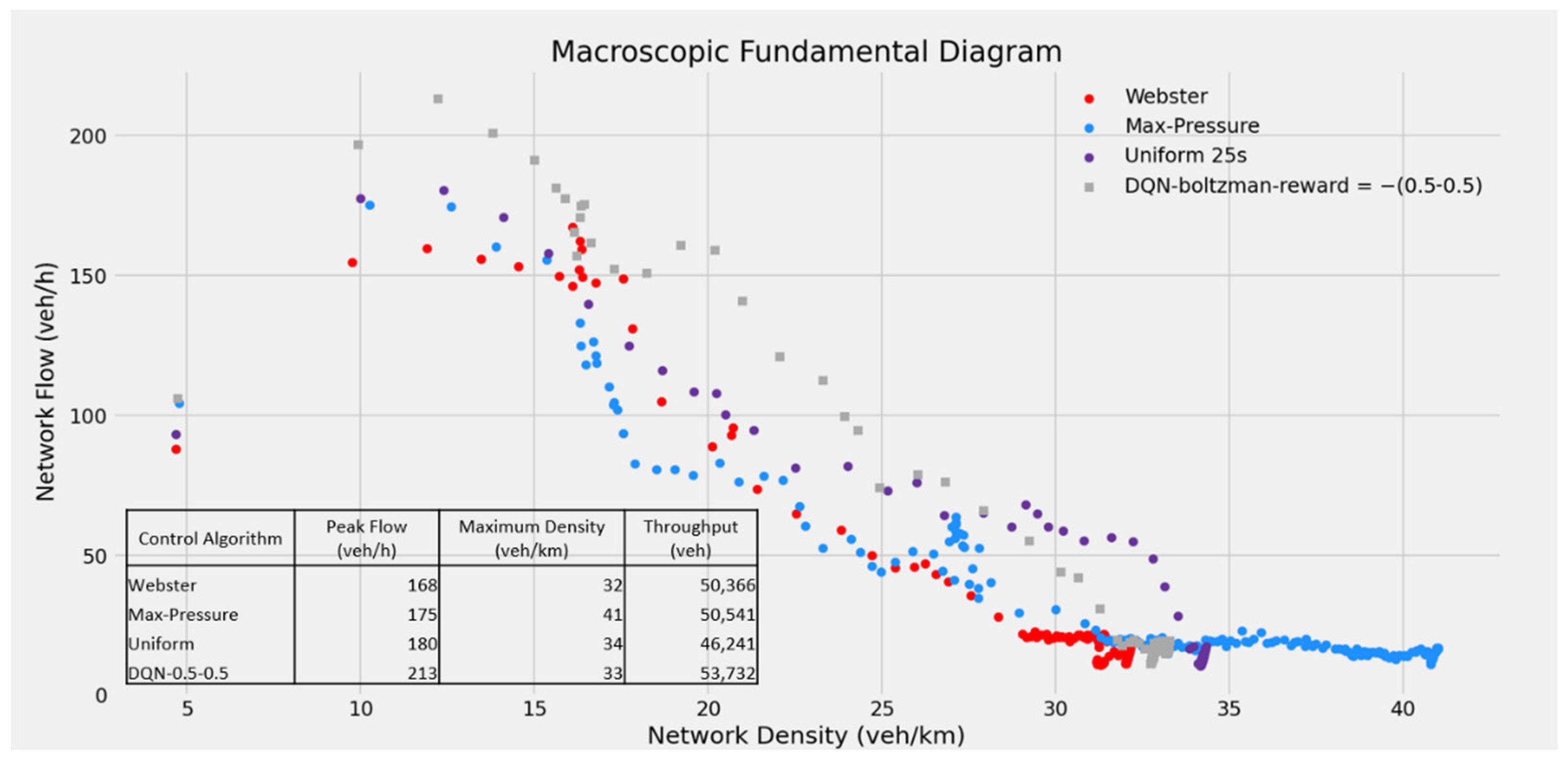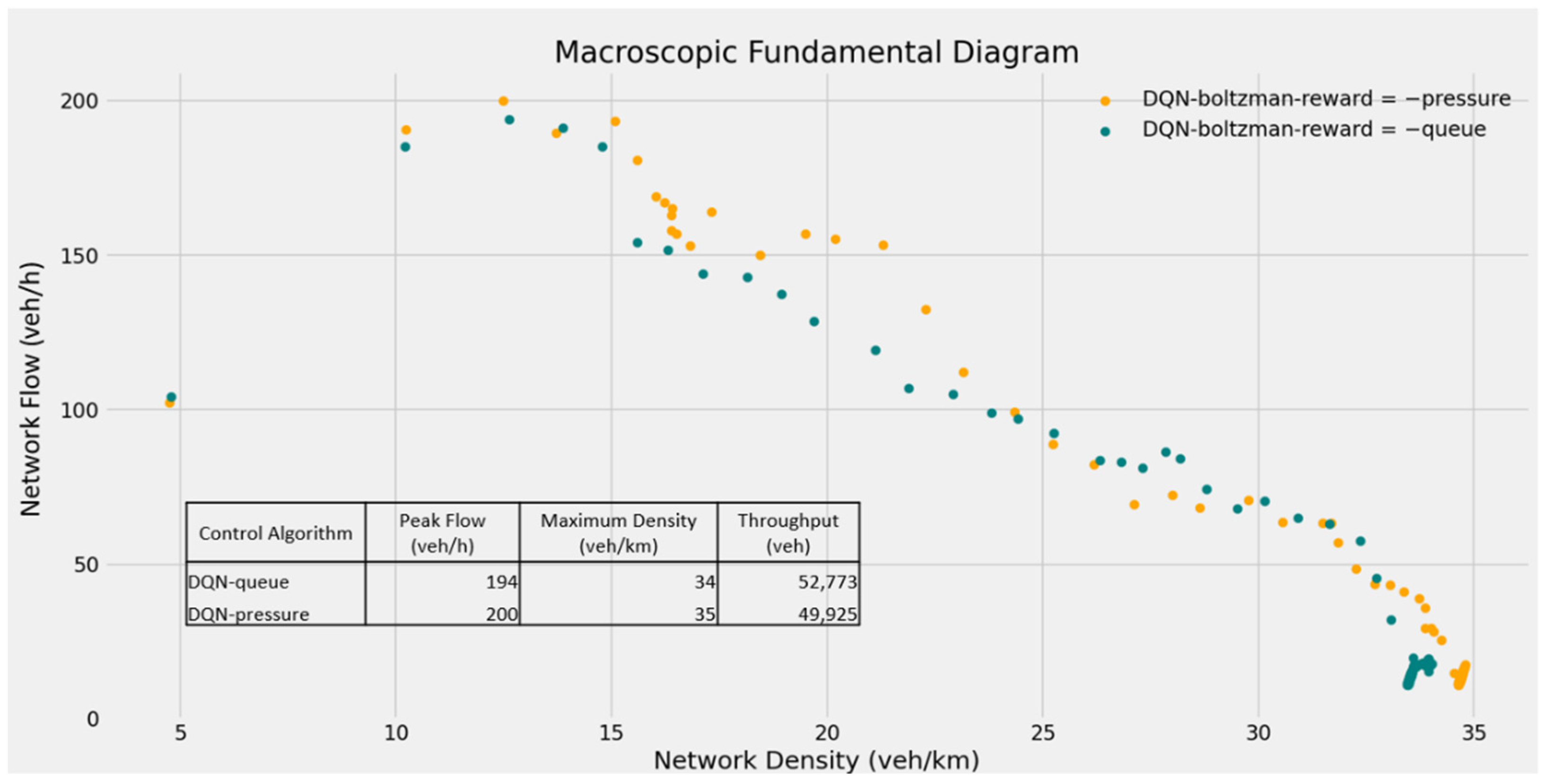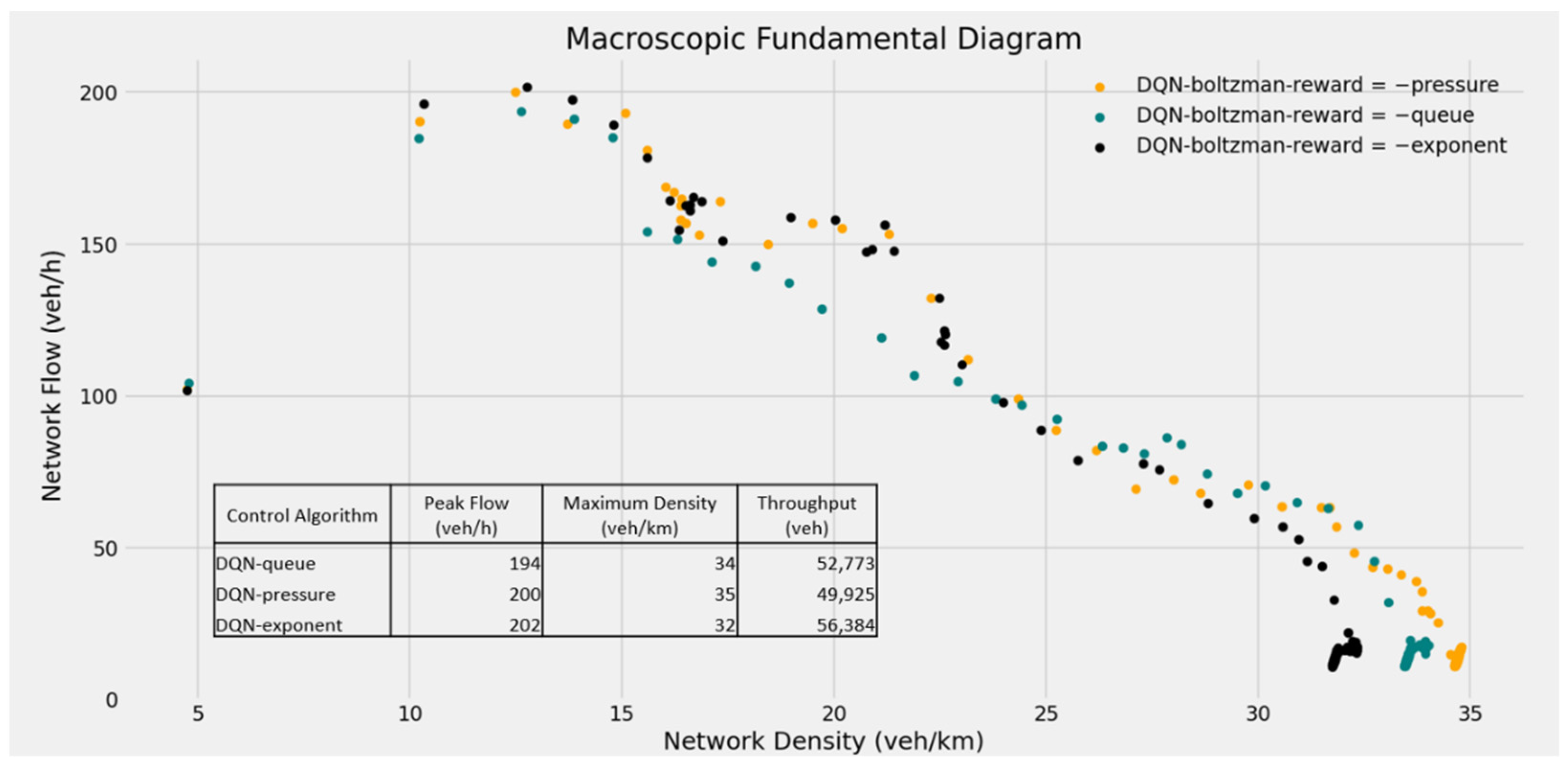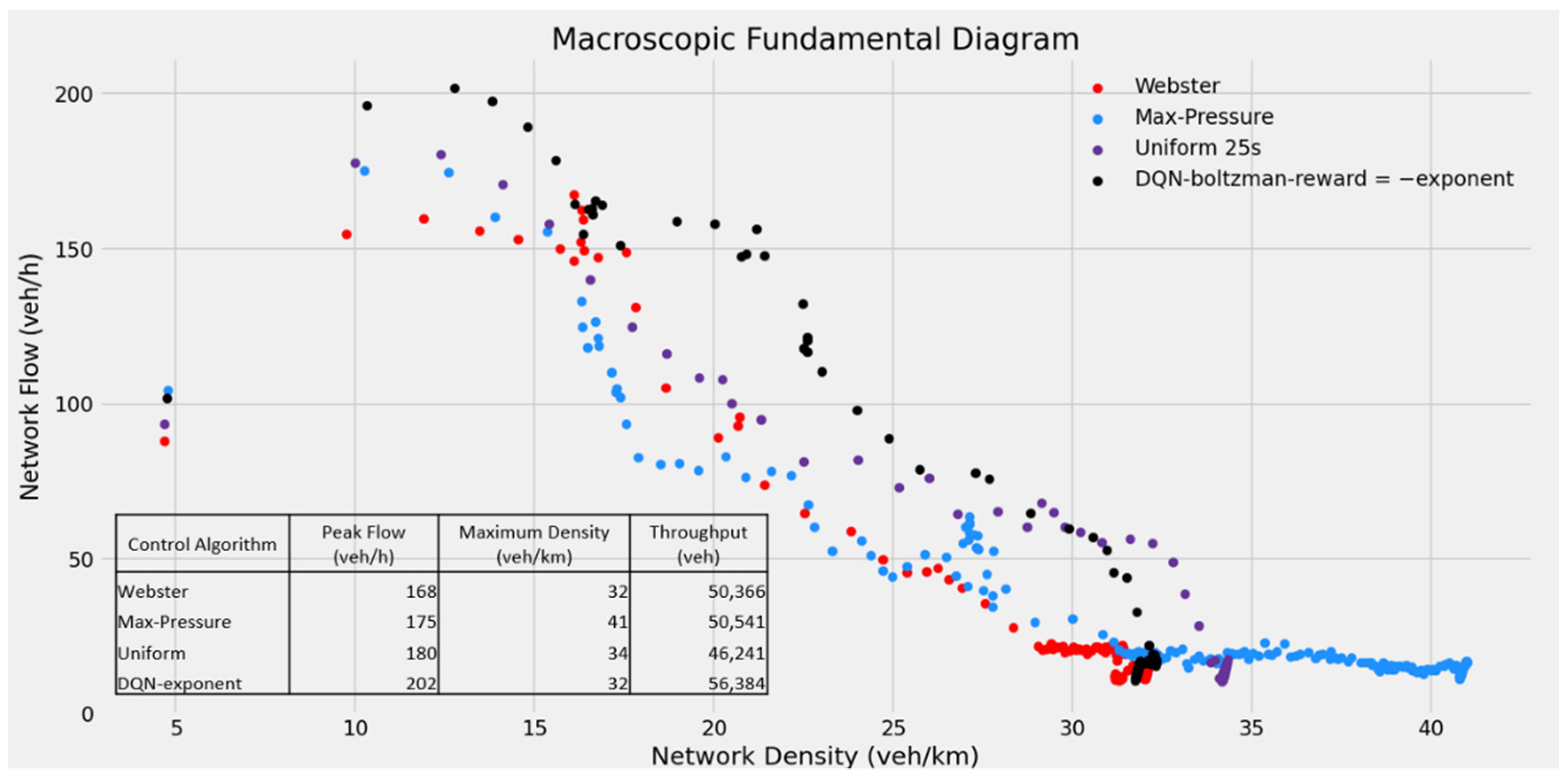1. Introduction
Congestion in transportation networks is growing because of the increasing demand for passenger and freight mobility. In urban areas with a lack of public transportation and low road capacity, preventing congestion highly depends on how effective the method used is, in handling the traffic control signals [
1]. In general, traffic signal operation is differentiated into two types of methods: fixed time and actuated/adaptive control methods. The first employs a repeating pattern with a fixed interval for each lane at an intersection during the cycle time (one period of the signaling system). This method does not consider the dynamics of the traffic [
2]. For the latter, adaptive control methods have been developed by incorporating the queue length of each lane as pressure on the signaling time, known as the max-pressure control [
3,
4], where the pressure is seen as the difference between the upstream and downstream queue length at the intersection, indicating an inequivalent vehicle distribution. Another notable adaptive method has been proposed by Webster, with the concept of minimizing the delay time per vehicle to optimize the signaling time, based on the queue density and road width [
5]. However, for highly complex urban transportation networks, the current approaches cannot be easily implemented without prior expert knowledge. This is because the representation of the traffic states must be carried out adequately when using a classical method [
6]. Adaptive and auto-generative solutions are required to solve congestion problems in highly connected transportation networks. In this paper, a deep Q-network reinforcement learning approach is investigated as a novel approach to optimal signaling control learning, based on changing traffic dynamics.
The max-pressure approach compares the pressure variation between the arms at an intersection [
3]. The setting of the decision process in the max-pressure only considers adjacent queues at each intersection, so it is a decentralized approach. Moreover, beyond basic serviceability, the max-pressure can operate without any prior knowledge of the traffic demand. This offers a significant advantage over most current traffic control systems, which necessitate a costly and time-consuming retiming procedure in the case of changes in demand patterns [
4]. Most studies on the max-pressure used artificial data sets and a grid network model. Subsequently, studies on the max-pressure utilizing real data from an arterial road were conducted [
4,
7]. Recent studies by Salomons and Hegyi [
8] and Joelianto et al. [
9] investigated the max-pressure with the assessment of its effectiveness using the macroscopic fundamental diagram (MFD) measure. However, a collaborative process is not present in the max-pressure, in spite of it being a decentralized approach. With highly connected transportation networks in urban areas, it is important for all intersections to collaborate while fulfilling the objective of optimizing the inflow and outflow of traffic. Hence, in this paper, a reinforcement learning approach is proposed around the idea of combining the max-pressure with the MFD assessment.
The MFD is a macroscopic congestion metric that makes it easier to model the traffic flow and explains the network outflow and vehicle accumulation in an urban network at an aggregate level [
10]. The MFD links the number of vehicles in a region to the rate at which trips are completed in that area when the network is uniformly congested, with demand changing gradually over time [
11]. Godfrey [
12] first postulated the idea of the MFD, but empirical data have only lately confirmed its reality [
13]. Gayah et al. [
14] investigated the effect of locally adaptive traffic signals on a network’s stability and the MFD. Yan et al. [
10] developed an iterative learning controller, based on the MFD and utilized it to control the signaling split in urban networks. All in all, using the MFD to control traffic signals is a current interest in optimizing traffic flow in urban areas.
Several reinforcement learning (RL) methods have been developed for solving traffic congestion at the city level. Recently, traffic system reinforcement learning methods have drawn interest because they can directly learn from complex conditions through training and rewarding without specific requirements on traffic model assumptions [
6]. In general, the learning process takes traffic conditions as states and signal configurations as actions at each intersection [
15]. The study by Chen et al. has shown that decentralized reinforcement learning satisfies scalability, coordination, and data feasibility [
16]. The formulation of decentralized RL agents in [
3] utilizes pressure from the max-pressure as the reward system. The objective of the decentralized RL agents is to minimize the pressure to balance the vehicle distribution and maximize the throughput in the traffic network.
Using intersections as self-learning agents in RL provides a powerful approach in formulating the traffic signal control problem because it does not depend on supervised learning labels. The characteristic of reinforcement learning allows agents to update the control signal in response to new observations of the dynamic traffic conditions in the environment. Thus, the presence of human experts in control parameter tuning, can be replaced by online learning or trial-and-error interaction. Recently, deep learning methods have been combined with RL, known as deep Q-learning. By utilizing the benefit of deep learning, the RL agents can learn to capture the relationship between states and actions by using the data structure. Q-learning is a model-free, off-policy, temporal difference reinforcement learning method that looks for the best course of action, given the current state of the agent. The learning method can sort out problems with stochastic transitions and rewards without requiring adaptation and has been applied in several investigations [
17,
18,
19,
20,
21,
22]. Deep reinforcement learning (DRL) has been used to control intersections via the deep-Q-network (DQN) by utilizing a neural network to approximate the Q value function [
23,
24,
25].
Both the max-pressure and RL can generally be seen as an optimization problem [
26]. In the RL methods, reward design is necessary to achieve an efficient learning process. The reward is the objective of the optimization, and the solution is based on a trial-and-error search to tell the agent if an action is good or not. Wei et al. [
26] defined the reward as pressure, which indicates the degree of disequilibrium between the vehicle density in the incoming and outgoing lanes. The max-pressure uses a greedy algorithm to minimize the pressure. If the reward function is set identical to the objective of the max-pressure, the same result can be achieved as with the max-pressure to maximize the network throughput [
26]. The reward design in [
27] considers the capacity of connecting lanes and upcoming vehicles from adjacent intersections. This reward is meant to avoid traffic congestion in the case of letting vehicles move into fully occupied lanes and RL is applied for the cooperative traffic signal system.
Reinforcement learning-based control can correct weaknesses resulting from previous actions. Thus, reinforcement learning can overcome the weaknesses of classical traffic control. Recently, Wu et al. [
28] conducted a large-scale traffic signal control study using distributed agent deep reinforcement learning by developing two new multi-agent reinforcement learning (MARL) algorithms, Nash-A2C and Nash-3AC, naturally incorporating the Nash equilibrium theory into the actor-critic architecture of deep reinforcement learning. Furthermore, a distributed IoT computing architecture was designed for the urban traffic that is much better suited to the distributed approaches. The reinforcement learning reward was defined by means of long-term traffic conditions (waiting time). In contrast, in the present paper, the reward is based on traffic stream properties (flow and density). This consideration is meant to improve traffic control performance when traffic conditions exceed the saturation flow condition. In this regard, the focus of this study was on constructing a reinforcement learning reward that can handle congestion in any traffic scenario instead of solely preventing congestion. This paper proposes an adaptive traffic control algorithm, based on a multi-agent reinforcement learning control using an exponential reward approach for urban intersection networks.
The designed reinforcement learning control algorithm selects the traffic phase to be activated, based on the pressure and queue length with the expectation that each selection is the optimal decision in each scenario that occurs. The MFD approach was employed to examine the performance of the reinforcement learning control macroscopically (overall traffic network model) rather than analyzing its effectiveness at each intersection. A reward function that prioritizes pressure will produce good results before reaching saturation flow, whereas a reward function that emphasizes queue length will achieve better outcomes after reaching saturation flow. Utilizing an exponential function approach, the adaptive reward is determined using a combination of the total pressure and the total queue length of the phase at an intersection, providing a reward that is adaptable to the vehicle density situation at any given moment. The proposed RL algorithm will be demonstrated using a traffic network model of Central Jakarta, as a case study.
This paper proposes a deep Q-network algorithm for traffic control, with the following contributions. (1) Designing an algorithm, based on reinforcement learning with the performance measured in terms of MFD to effectively control the traffic in various traffic conditions. (2) Multi-agent DQN is used to approximate the Q-value to determine the action taken by the agent at each intersection. (3) The adaptive reward function uses an exponential approach that is based on the combination of the total pressure and the total queue length of the phase at an intersection. (4) The developed controller can prevent the vehicle flow from becoming completely jammed (gridlock) and increase the number of vehicles that successfully complete their trips in the simulation (maximum throughput).
The rest of this paper is organized as follows.
Section 2 provides the problem formulation for the traffic network as well as explanations of the max-pressure traffic control method, the Webster traffic control method, and the macroscopic fundamental diagram.
Section 3 describes the design of the proposed reinforcement learning traffic control using the deep Q-network, as well as the agent design.
Section 4 shows an implementation of the controller in a traffic network using the proposed reward function.
Section 5 presents the result and its discussion, and
Section 6 presents the conclusion and discusses future work.
3. Reinforcement Learning in Traffic Control
Reinforcement learning can be conducted through trial and error without making unfounded assumptions about the traffic model [
35]. Reinforcement learning capabilities are needed because traffic circumstances are always changing and becoming more complicated so that the assumptions that were used in developing the traffic model become irrelevant to actual conditions. Utilizing reinforcement learning, the control algorithm can generate strategies for controlling a traffic system, based on the feedback obtained. In traffic control scenarios, the reinforcement learning agent receives various forms of information, such as queue length, waiting time, traffic flow, and so forth, at any given moment. The information on traffic conditions provided to the agents describes the state of the environment to be used as the basis for the agents to select an action.
3.1. Reinforcement Learning
The concept of reinforcement learning is that an agent interacts with an environment, taking action, and learning through trial and error to maximize its cumulative rewards over time. The way a learning agent interacts with its environment, as manifested in states, actions, and rewards, is defined by reinforcement learning with the formal framework of the Markov decision process (MDP) [
36]. The Markov decision process is represented by a tuple
, which stand for states, actions, transition probabilities, rewards, and discount factor, respectively. The probability distribution of the next state is defined by
when any action
is taken at any state
give a new state
and an expected reward
. A policy
for the MDP is a mapping of any state
to a probability distribution over
, while the state-value function
defines the expected return reward when starting in a particular state
s and adhering to policy
[
36], defined as,
Correspondingly, the expected return reward while starting in a particular state
, taking the action
, and adhering to policy
is defined by the action-value function
[
36], that is,
The purpose of reinforcement learning is to determine the policy that maximizes the cumulative reward. A policy
can be ensured to be optimal if its expected return reward is higher than or equal to that of policy
for all states. As in [
36], the optimal state-value function
and action-value function
are essentially defined as follows to describe optimality,
These functions provide the expected return reward for taking action
in state
and then implementing an optimal strategy for the state-action pair
. Based on [
36], Equation
can be expressed in terms of
as follows:
Under an optimum policy, the value of a state must be equal to the expected return reward for the optimum action related to that state. To evaluate this, the Bellman optimality equation [
36] is used, which can be expressed in terms of
and
as follows,
Several approaches have been proposed to provide optimal solutions, including value iteration [
37,
38], policy iteration [
39,
40], SARSA [
41,
42], and Q-learning [
43,
44].
3.2. Deep Q-Network
The deep Q-network (DQN) is a value-based reinforcement learning algorithm that uses deep neural network
to approximate the optimal Q-function (action-value function)
[
45]. The neural network receives a state
as input and produces an estimate of the Q-value for all potential actions
as output. This demonstrates how the neural network maps states to specific actions, based on each action value. Instead of utilizing the last obtained experience to update the Q-function, the DQN stores the transition as a tuple
in replay memory
, and then utilizes a mini batch to sample the experiences uniformly, at random to train the parameters of the neural network by using the stochastic gradient descent. The DQN uses the replay memory to both limit network learning from interconnected experiences and to enable re-learning from prior experiences.
The DQN utilizes two distinct neural networks: the target neural network
and the online neural network
. The DQN calculates the target
and estimation
for each experience using the target network and the online network, respectively. Thus, the loss function to update the parameters of online network
can be expressed as follows [
46],
The target network parameters are only updated periodically to the online network parameters. Training can progress more steadily in this approach. In essence, the goal of the DQN is to match the estimated Q-value to a more precise target.
The
ϵ-greedy exploration approach is often used to define the new policy during an iteration. An action is chosen randomly for every state
s with probability
ϵ. If its probability equals 1 −
ϵ, the action that maximizes
Qt is selected. Other approaches for determining new policies exist, such as the Boltzmann exploration [
36]. The Boltzmann exploration determines the action, based on the Boltzmann distribution (softmax) and the Q-value acquired, influenced by temperature parameter
τ. The parameter
τ describes the activeness of an action. When the temperature is greater
, practically all of the actions have the same probability, whereas when the temperature is lower,
, the probability with the maximum Q-value is very close to one. The Boltzmann function [
36] is expressed as follows,
The selected action will be determined by the maximum value derived from the softmax function. The benefit of the Boltzmann exploration over ϵ-greedy is that the information regarding the potential value of alternative actions can also be considered.
3.3. Agent Design
(1) State. The state consists of four traffic features representing the traffic state at each intersection, namely an array indicating the currently active green phase, a binary variable showing whether the minimum green time in the current phase has already passed, the density of incoming vehicles at each phase, and the queue length of incoming vehicles at each phase. The density and queue length are defined for each phase to assist the agent in making an action decision.
(2) Action. The action a is in the form of the phase selection at each intersection. In the traffic network model, each intersection has a different number of phases, which may be two or three phases. The agent will evaluate the performance of the action every five seconds and can then choose another action. The selected action has a maximum duration of 25 s.
(3) Reward. In this paper, the reward is defined based on the max-pressure, quantifying the pressure of the upstream and downstream traffic at an intersection. The reward,
, is defined as,
where
is the pressure at intersection
,
is the number of the phase,
and
are the numbers of the upstream and downstream vehicles, respectively, and
and
are the lengths of the upstream and downstream lanes. In this study, the following reward variation was used,
Equation (21) defines the combination of the total intersection pressure and total queue length of vehicles at the intersection with varying pressure and queue length weights. The variables and represent the phase pressure at time and the queue length in the upstream phase at time , respectively. The values of weight coefficients and indicate the preferred reward.
5. Result and Discussion
This section presents the experiments to evaluate the control performance of the deep Q-network. This paper deals with traffic control on a large-scale system, consisting of 31 controlled traffic intersections in Central Jakarta, spread over the Menteng and Senen districts, as shown in
Figure 5. The traffic network modeling and simulation was performed in Eclipse SUMO 1.11.0. The incoming vehicle data, turning ratio, and traffic phase were taken from TomTom and SCATS on 17 January 2020. The incoming vehicle data was constructed only at the entry points on the edges of the traffic network model, while the turning ratio was constructed at every turning point in the modeled traffic network. The ratio of the simulated vehicles consisted of 23.7% passenger cars, 2.5% buses, 4.6% trucks, and 69.2% motorcycles. The traffic phase was assigned at every controlled intersection, with each intersection having two or three traffic phases. The DQN was implemented using the Keras framework and communicated with SUMO through TraCI. The DQN was trained for fifty episodes from 08.00 to 09.00 and tested from 06.00 to 23.00. The DQN hyperparameters are shown in
Table 1.
In this research, we analyzed the traffic control performance using the MFD to represent the relationship between the vehicle flow and the vehicle density in the traffic network. The DQN algorithm was first combined with an action selection method, known as ϵ-greedy exploration, with the reward defined as the total pressure at the intersection. This traffic control algorithm was applied to a traffic model of Central Jakarta, yielding the MFD graph results shown below.
Figure 6 shows that the developed DQN algorithm achieved a higher peak flow (202 veh/h) than the classical and conventional control algorithms employed as a comparison, namely Webster (168 veh/h), the max-pressure (175 veh/h), and the uniform (180 veh/h). However, the developed DQN control had a lower throughput value (45,262 vehicles) than the classical controls. These results indicate that while the DQN algorithm’s peak flow was higher than the classical controls’ peak flow, this high flow could not be sustained over time. This condition caused vehicles to accumulate in the network, increasing the network density as the simulation progressed. Furthermore, in terms of the vehicle density distribution, the developed reinforcement learning method was unable to minimize the congestion. As seen in
Figure 6, the vehicle density pattern continued to expand to the right area when the vehicle flow hit the lowest point, indicating that the MFD DQN control reached the L
4 region. In the MFD, the L
4 region indicates that the simulated traffic has reached a gridlock condition. In order to improve the performance of the traffic control algorithm, the action selection method was replaced with the Boltzmann exploration.
Figure 7 shows the MFD graph using the Boltzmann exploration technique.
Once the action selection method was replaced with the Boltzmann exploration, the condition of maximum density in the traffic network was reduced to 35 veh/km, accompanied by an insignificant decrease of the peak flow from 202 veh/h to 200 veh/h. The resultant throughput value grew from 45,268 vehicles to 49,923 vehicles but was still lower than with the max-pressure and the Webster. The next step in improving the DQN control’s performance was to vary the reward
by including the queue length in addition to the pressure reward, according to Equation (21). The value variations of the coefficients
and
investigated in this study are shown in
Table 2.
Figure 8 depicts the MFD graph with the variation of the reward weight coefficient. Each adjustment of the weight coefficient value yielded an MFD with a varying control performance. The coefficient values prioritizing pressure rewards (DQN-0.9-0.1 and DQN-0.7-0.3) compared to the coefficient values prioritizing the queue length reward (DQN-0.3-0.7 and DQN-0.1-0.9) tended to produce a greater peak flow but were accompanied by a considerably higher vehicle density. The DQN-0.5-0.5 agent generated better performance outcomes, compared to the variation of other coefficient values. Although the DQN-0.5-0.5 produced a maximum vehicle density of 33 veh/km (greater than the DQN-0.1-0.9 at 30 veh/km), this value was compensated by the higher peak flow from other variations (213 veh/km). The DQN-0.5-0.5 provided the highest throughput, indicating that it could maintain a high vehicle flow for a long period of time. The DQN-0.1-0.9 had a low throughput value, generating the lowest maximum vehicle density and reducing the number of vehicles that could enter the traffic network model, instead of increasing the number of vehicles exiting the network model.
The DQN-0.5-0.5 agent achieved better results, in terms of the vehicle flow and throughput, when compared to the classical and conventional control algorithms shown in
Figure 9. In terms of the vehicle density, the Webster control was able to produce a lower maximum vehicle density. The DQN-0.5-0.5 failed to prevent the vehicle density in the MFD from exceeding the L
4 condition, resulting in a greater maximum vehicle density than with the Webster control. According to
Figure 9, the vehicle density continued to shift to the right after attaining a lower vehicle flow (15 veh/h at 31 veh/km density). In order to improve this density condition, the variation of the other reward weight coefficient values must be re-tested.
However, due to the lengthy processing time required for testing, this trial-and-error strategy is rendered ineffectual. In addition to the lengthy computation time, the employment of a fixed incentive weight coefficient from start to finish is deemed improper. The MFD can be regarded as consistent from start to finish if it exhibits the greatest flow peak followed by the lowest maximum density when compared to the other control algorithm variations. As can be seen in
Figure 8, the MFD revealed that there was no consistent coefficient variation from the start to the end of the simulation. In order to simplify the analysis of this condition, the MFD graph was evaluated when the rewards supplied to the DQN agents were full pressure and queue length. As shown in
Figure 10, the DQN-pressure agent had a greater peak flow than the DQN-queue agent, although this value was accompanied by a higher maximum vehicle density. Furthermore, the DQN-pressure failed to maintain the trend of the decreasing density in the 23 veh/km and 27 veh/km density region.
The density downward trend shown in
Figure 10 indicates that there was a performance exchange between the DQN-pressure and the DQN-queue in the density range of 23 veh/km to 27 veh/km. Therefore, we need a DQN agent that can swap between the pressure rewards and queue rewards in this performance area to acquire the optimum performance for each condition. A technique for a weight reward coefficient that is adaptable to the vehicle density circumstances is proposed to suit this demand, namely an adaptive weight reward. The reward equation that calculates the adaptive weight is shown in Equation (26). In order to simplify the testing of this adaptive reward mechanism, the midpoint value of the performance exchange area in the MFD was used, 25 veh/km. As the midpoint (exchange point), both
and
should be equal to 0.5. The
value that produced a density of 25 veh/km was 0.0277. The MFD derived from the implementation of this adaptive reward mechanism technique is shown below.
Figure 11 illustrates that the DQN agent with adaptive reward mechanism (DQN-exponent) produced the highest peak flow and could maintain the maximum density (32 veh/km) at the lowest value, compared to the DQN-pressure and DQN-queue agents. The MFD graph also demonstrates the adaptability of the DQN-exponent, since when the vehicle density was low (less than 25 veh/km), the MFD pattern provided by the DQN-exponent replicated that of the DQN-pressure, while when the vehicle density was high, the MFD pattern resembled that of the DQN-queue. In terms of the throughput, the DQN-exponent provided the highest value, implying that the low maximum density in the MFD resulted from the DQN agent’s capacity to facilitate vehicles to exit the network model. Furthermore, the DQN-exponent agent’s performance was compared to the classical controls that were utilized in the initial comparison. The MFD graphs of the control algorithms were compared as follows.
Figure 12 illustrates that the DQN agent with an adaptive reward mechanism (DQN-exponent) achieved the highest peak flow (202 veh/h) and could maintain the maximum vehicle density with the lowest value (32 veh/km), when compared to the classical control algorithms utilized as a comparison. The DQN-exponent succeeded to provide a higher throughput value (56,384 veh) than the classical control algorithms.
Additionally, the advanced traffic sensing method can be employed to obtain more accurate traffic information. Recently, Pu et al. [
47] developed a multimodal traffic speed monitoring, based on the passive Wi-Fi and Bluetooth sensing technology. Because the vehicle detector loop has a limited range from the signalized intersection, the accurate vehicle speed information can be acquired utilizing their research if congestion occurs in the middle of road segments. As a result, this strategy may improve the traffic control performance.
6. Conclusions
This paper proposed the adaptive deep Q-network algorithm with an exponential reward mechanism for the traffic control in an urban network, consisting of 31 intersections in Central Jakarta, spread over the Menteng and Senen districts. The adaptive reward mechanism, based on an exponential equation technique was developed to adjust the weight reward coefficient to the vehicle density condition. The Jakarta traffic network model was constructed utilizing real vehicle input data through SUMO and SCATS to reproduce real-world circumstances.
The adaptive deep Q-network algorithm with the exponential reward mechanism achieved the highest throughput (56,384 vehicles), compared to the classical control algorithms, the max-pressure (43,294 vehicles), the Webster (50,366 vehicles), and the uniform (46,241 vehicles). The significant increment of the vehicle throughput indicates that the traffic control could improve the region productivity, signifying that an intersection could handle more vehicles, reducing the congestion possibility. The proposed DQN prevented the vehicle density in the network from reaching the L4 MFD region with a maximum density of 32 veh/km, in contrast to the classical control algorithms, which failed to prevent this condition.
The pressure calculation used has a limitation. The lane’s maximum capacity in the pressure calculation was substituted by the length of the relevant lane, considering that different types of vehicles have different lengths. This approach assumes that lane capacity and length are directly proportional. In future work, it is necessary to evaluate the adaptive reward utilizing different equational approximations, besides the exponential approximation. Reinforcement learning action in the form of cycle length needs to be considered to meet real-world circumstances.
